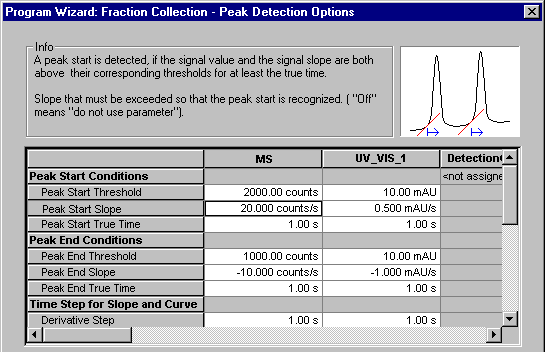Collecting Fractions
![]() Detecting the Peak Start, Peak Maximum, and Peak End (Peak Detection Options)
Detecting the Peak Start, Peak Maximum, and Peak End (Peak Detection Options)
To ensure that the Fraction Collector fills the tube, the peak start, peak maximum, and peak end all must be correctly detected. Select the necessary settings on the Peak Detection Options page of the Program Wizard or PGM Editor, select the channel(s) for fraction collection. (The Control Program section provides more information about the ![]() Program Wizard and
Program Wizard and ![]() PGM Editor.)
PGM Editor.)

Peak Start
The prerequisites for detecting the peak start (and hence, the beginning of a fraction) are as follows:
No peak start has been detected so far.
Fraction collection and peak detection are enabled via the CollectFractions = ByPeak.
The signal of the detection channel is greater than the signal defined by PeakStartThreshold.
The signal slope is greater than the slope defined by PeakStartSlope.
Data acquisition on the selected channel is not yet completed.
The run itself is not completed yet
The conditions are fulfilled for the PeakStartTrueTime. (The default setting is 1.00 s. The allowed range is 0.00 to 4.00 s.)
The PeakStartThreshold and PeakStartSlope variables influence the peak detection sensitivity.
The PeakStartSlope variable can be changed within broad limits. The higher the value is, the later the peak start is detected. If the detector signal exceeds the PeakStartThreshold, the peak is detected only if the slope threshold value is also exceeded.
Chromeleon remembers a peak start so that a peak maximum can be detected next. Thus, a peak maximum can be detected only if a peak start has been detected before.
Peak Maximum
The peak maximum is detected only if
A peak start has been detected before.
No peak maximum has been detected yet.
The signal slope is smaller than the signal slope defined by PeakMaxSlope.
The conditions are fulfilled for the time specified by PeakMaxTrueTime. (The default setting is 1.00 s. The allowed range is 0.00 to 4.00 s.)
A peak maximum can be detected only if a peak start has been detected before. Thus, if no peak start has been detected, no maximum will be detected either. The PeakMaxSlope variable is defined as negative slope value as it applies to the tailing side of the peak. The closer the value is to zero, the closer to the peak maximum the PeakMaxRecognition Trigger is executed.
Chromeleon remembers a peak maximum so that a peak end can be detected next. Thus, a peak end can be detected only if a peak maximum has been detected before (unless one of the end-run conditions apply).
Peak End
A peak end (and hence the end of a fraction) is detected if:
The signal slope is less than the signal slope defined by PeakEndSlope and
The signal of the detection channel is less than the signal defined by TresholdNoPeakEnd and
A peak maximum has been detected before.
OR:
The signal of the detection channel is less than the signal defined by PeakEndThreshold and
A peak maximum has been detected before.
OR:
A peak start has been detected before and
Data acquisition on the signal channel has been finished
AND:
The conditions are fulfilled for the PeakEndTrueTime. (The default setting is 1.00 s. The allowed range is 0.00 to 4.00 s.)
The first group of conditions checks whether the signal is below a limit, which is defined by the ThresholdNoPeakEnd variable. With heavily overloaded detector signals, there is a lot of signal noise, so a peak end and/or start would be detected several times near the top of the peak. The top of the peak could also be formed like a plateau. To inhibit this, set the ThresholdNoPeakEnd variable to a value below this level. If the value is set to Off, this part of the condition will always be true and this check will be disabled. PeakEndSlope delays the peak end.
The second group of conditions uses the signal height criterion. If the signal value falls below PeakEndThreshold, the peak is completed.
The third group of conditions completes the current peak in case the data acquisition is disabled.
For more information, refer to:
![]() Entering More Peak Detection Parameters (Peak Detection Options)
Entering More Peak Detection Parameters (Peak Detection Options)
![]() Defining the Reactions to Certain Events
Defining the Reactions to Certain Events
For an overview of the fraction collection topics, refer to ![]() Collecting Fractions.
Collecting Fractions.